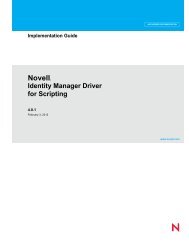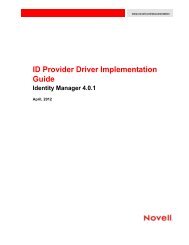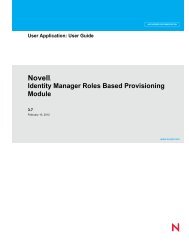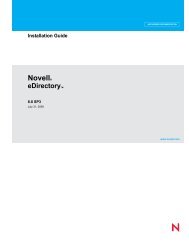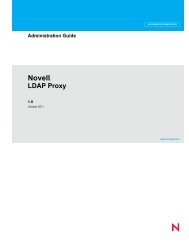Identity Manager 4.0.2: RBPM and Reporting Migration Guide - NetIQ
Identity Manager 4.0.2: RBPM and Reporting Migration Guide - NetIQ
Identity Manager 4.0.2: RBPM and Reporting Migration Guide - NetIQ
You also want an ePaper? Increase the reach of your titles
YUMPU automatically turns print PDFs into web optimized ePapers that Google loves.
Security Officer<br />
To determine the Security Officer assignments:<br />
1 Compile a list of the identities (users, groups, containers <strong>and</strong> roles) that have Security Officer<br />
assigned. This can be done by logging in as security administrator, going to the Role Catalog <strong>and</strong><br />
viewing the list of assignments for the Security Officer role. Alternately, you can develop a Java<br />
utility (as described in Section 1.4.4, “Sample Code,” on page 28). Here are the steps to compile<br />
the Security Officer assignment list before migration:<br />
1a Login to the User Application as Role Administrator.<br />
1b Navigate to the Roles tab.<br />
1c Select Role Assignments in the left navigation menu.<br />
1d Lookup the Security Officer role <strong>and</strong> compile a list of all identities assigned as Security<br />
Officer (users, groups, containers). Let's call the list security officer assignment list.<br />
1e Select Manage Role Relationships in the left navigation menu.<br />
1f Lookup the Security Officer role <strong>and</strong> add all parent role assignments to the security officer<br />
assignment list.<br />
1g If the Security Officer role has any child role assignments, compile the list of child roles.<br />
2 Compile a list of SoDs for each identity, assigned as Security Officer, having browse rights to the<br />
user, group, or container. This can be done via i<strong>Manager</strong>, Designer, or an LDAP browser.<br />
Alternatively, you can develop a Java routine (as described in Section 1.4.4, “Sample Code,” on<br />
page 28).<br />
To determine the SoD browse rights for an identity in i<strong>Manager</strong>:<br />
2a Go to View Objects.<br />
Auditor<br />
2b Browse the eDirectory Tree to your identity.<br />
2c Select the identity in the table in the right pane <strong>and</strong> select Actions > Rights to Other Objects.<br />
2d In the Rights to Other Objects dialog that appears, check the Search entire subtree check box<br />
<strong>and</strong> press OK.<br />
2e Make note of all the SoDs for which the identity has Browse rights.<br />
To determine the Auditor assignments:<br />
1 Compile a list of identities (users, groups, containers, <strong>and</strong> roles) that have Auditor assigned.<br />
This can be done by logging in as security administrator, going to the Role Catalog <strong>and</strong> viewing<br />
the list of assignments for the Auditor role. Alternately, you can develop a Java utility (as<br />
described in Section 1.4.4, “Sample Code,” on page 28).<br />
Here are the steps to compile the Auditor assignment list before migration:<br />
1a Login to the User Application as Role Administrator.<br />
1b Navigate to the Roles tab.<br />
1c Select Role Assignments in the left navigation menu.<br />
1d Lookup the Auditor role <strong>and</strong> compile a list of all identities assigned as Auditor (users,<br />
groups, containers). Let's call the list auditor assignment list.<br />
1e Select Manage Role Relationships in the left navigation menu.<br />
1f Lookup the Auditor role <strong>and</strong> add all parent role assignments to the auditor assignment list.<br />
1g If the Auditor role has any child role assignments, compile the list of child roles.<br />
20 <strong>Identity</strong> <strong>Manager</strong> <strong>4.0.2</strong>: <strong>RBPM</strong> <strong>and</strong> <strong>Reporting</strong> <strong>Migration</strong> <strong>Guide</strong>




